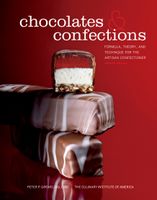Advertisement
Chocolate Storage Guidelines
By Peter Greweling and Culinary Institute of America
Published 2007
Because chocolate contains virtually no moisture, it has a very low water-activity level and is not prone to bacterial spoilage during storage, resulting in a long shelf life. (See Water Activity.) The factor limiting shelf life for chocolate is rancidity, the breakdown of fats that can create off flavors. Although cocoa butter is relatively resistant to rancidity, chocolate should be stored protected from exposure to oxygen, light, heat, and moisture. In addition, when working with chocolate, do not expose it to reactive metals such as copper and iron. All of these factors shorten the potential shelf life of chocolate products by increasing the likelihood that rancidity will develop. When stored under ideal conditions, dark chocolates have a shelf life of approximately twelve months, while milk and white chocolate have a shelf life of approximately six months. These are the maximum times suggested for storing chocolate. The artisan confectioner is well advised to turn over his chocolate inventory much more rapidly to ensure the highest-quality products with the freshest flavor.



